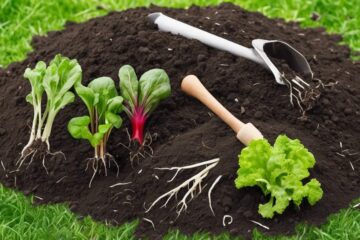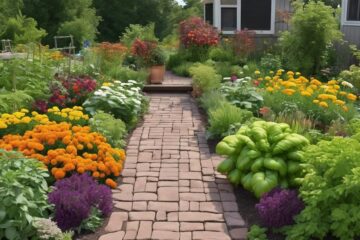When it comes to coaxing the best out of your root vegetables in clay soil, you might find yourself in a bit of a sticky situation. However, fear not, as there are ten invaluable tips awaiting your eager green thumb.
From selecting the right veggies to nurturing their growth, each step holds the key to a bountiful harvest. So, are you ready to unearth the secrets that will transform your clay soil into a thriving garden bed for root vegetables like never before?
Understanding Clay Soil Composition
Have you ever wondered what makes clay soil so challenging for root vegetables to thrive in?
Clay soil's dense and compact nature hinders root growth and drainage. The tiny particles in clay soil can stick together, creating an environment where plant roots struggle to penetrate. Compacted clay further restricts oxygen flow, affecting the overall health of root vegetables.
To improve clay soil for root vegetable growth, adding organic matter is key. Organic matter helps break up the dense clay, improving drainage and nutrient availability for the plants.
While clay soil may pose challenges, with proper management and amendments like organic matter, it can provide a suitable environment for cultivating root vegetables.
Benefits of Growing Root Vegetables
Root vegetables offer a host of benefits that make them a valuable addition to your garden, from their quick maturation to their nutrient density and versatility in cold temperatures. Here are three reasons why growing root vegetables can enhance your gardening experience:
- Nutrient-Dense: Root vegetables are packed with essential vitamins and minerals, making them a healthy choice for your diet.
- Versatility in Cooler Temperatures: These vegetables thrive in cooler weather, resulting in sweeter roots with improved flavor and texture.
- Quick Maturation: With the right care and planting schedule, root vegetables can mature rapidly, allowing you to enjoy your harvest sooner.
Include root vegetables in your garden to enjoy these benefits and elevate your gardening experience.
Importance of Soil Preparation
Properly preparing the soil is essential for maximizing the growth and yield of root vegetables in clay soil. When dealing with clay soils in your garden, soil preparation becomes even more critical to overcome the challenges it presents. Adding soil amendments such as compost, sand, and gypsum can greatly enhance the structure and drainage of clay soil, creating a more hospitable environment for root vegetables. Testing the soil pH and nutrient levels before planting root vegetables is key to determining the necessary amendments for successful growth in clay soil. Adequate soil preparation not only improves drainage but also enhances root development, facilitates better nutrient uptake, and promotes overall soil health, leading to thriving root vegetables.
| Soil Amendments | Benefits |
|---|---|
| Compost | Improves soil structure |
| Sand | Enhances drainage |
| Gypsum | Aids in breaking up clay soil |
Choosing Root Vegetables Wisely
When selecting root vegetables for planting in clay soil, consider their adaptability to compacted conditions and root system characteristics. Here are some tips to help you choose wisely:
- Opt for root vegetables like carrots, radishes, and beets known for thriving in clay soil with their ability to penetrate compacted ground.
- Look for varieties with shallow root systems or robust roots, such as turnips, onions, and potatoes, which can excel in such conditions.
- Selecting the right root vegetable varieties suited for clay soil can lead to nutrient retention, promoting healthy growth and a bountiful harvest, ensuring a productive gardening experience. Choose wisely for a successful and rewarding harvest.
Enhancing Clay Soil Drainage
To enhance drainage in clay soil, consider incorporating organic matter like compost and sand into the soil. These additions help improve soil structure, allowing water to drain more effectively.
Applying gypsum can also aid in breaking up compacted clay particles, further enhancing drainage.
Utilizing raised beds or containers is another effective method to improve drainage in clay soil settings. Proper spacing between plants and employing suitable planting techniques can prevent waterlogging, ensuring healthier root development.
By mulching the soil surface, moisture retention is facilitated while preventing compaction issues common in clay soil.
Implementing these strategies will create a more favorable environment for root vegetables to thrive in clay soil conditions.
Organic Matter for Improved Soil Structure
Enhancing your clay soil's structure can be effectively achieved by incorporating organic matter such as compost or manure. Here are three key benefits of using organic matter for improved soil structure:
- Increased Nutrient Absorption: Organic matter like compost helps break up dense clay particles, allowing roots of your root vegetables to better absorb essential nutrients.
- Enhanced Moisture Retention: Organic matter acts like a sponge in clay soil, aiding in moisture retention crucial for the healthy growth of root vegetables.
- Prevention of Soil Compaction: Mixing in well-decomposed organic matter helps prevent soil compaction in clay soil, promoting healthier root growth and overall plant development.
Mulching Techniques for Moisture Retention
Mulching in clay soil significantly improves moisture retention by reducing evaporation rates. Organic mulches such as straw, leaves, or compost can enhance soil structure and water retention, benefiting root vegetables. Apply a 2-4 inch layer of mulch around your root vegetables to help maintain consistent moisture levels. Besides moisture retention, mulching also plays a role in regulating soil temperature, shielding roots from extreme heat or cold. Furthermore, proper mulching practices aid in reducing soil compaction, fostering healthy root growth in clay soil. Check out the table below for a quick overview of the benefits of mulching:
| Mulching Benefits | Clay Soil | Root Vegetables |
|---|---|---|
| Moisture Retention | Reduces Evaporation Rates | Consistent Moisture Levels |
| Soil Structure Improvement | Enhances Water Retention | Healthy Growth |
| Temperature Regulation | Shields Roots | Optimal Conditions |
Rotating Root Vegetable Crops
If you want to maintain healthy soil and optimize root vegetable growth in clay soil, consider the benefits of rotating your root vegetable crops regularly.
Here are some key points to keep in mind:
- Preventing Soil-borne Diseases: Rotating root vegetable crops helps prevent the buildup of soil-borne diseases and pests in clay soil.
- Improving Soil Structure and Fertility: Changing root vegetable varieties each season can lead to improved soil structure and fertility over time.
- Balancing Nutrient Levels: Crop rotation with root vegetables like carrots, beets, and radishes helps maintain balanced nutrient levels in the soil.
Monitoring Soil Health Regularly
Regularly monitoring soil health is essential to ensure optimal conditions for root vegetable growth in clay soil. Clay particles in clay soil can lead to poor drainage, affecting root development.
Check soil pH regularly to maintain the ideal range for nutrient availability to root vegetables. Conduct soil testing to assess nutrient levels and adjust fertilization accordingly.
Monitoring soil compaction is crucial to prevent root restriction and promote healthy root development. By staying vigilant about soil health, you can address issues promptly and create a conducive environment for root vegetables to thrive in clay soil.
Successful Harvesting and Storage
For successful harvesting and storage of root vegetables in clay soil, timing is crucial to ensure optimal flavor and texture.
- Harvest at the Right Time: Harvest root vegetables when they reach the optimal size for the best flavor and texture.
- Proper Storage: Store root vegetables in a cool, dark, and humid environment to prolong freshness.
- Prevent Moisture Loss: Remove the tops of root vegetables before storing to prevent moisture loss.
To improve the heavy clay soil where you grow root vegetables, consider adding organic matter like compost and organic fertilizer. Some of the best vegetables to grow in clay soil include carrots, radishes, and beets.
If your clay soil is challenging, consider growing root vegetables in a raised bed or container to better control the soil quality and drainage.
Frequently Asked Questions
How Do You Grow Root Vegetables in Clay Soil?
To grow root vegetables in clay soil, you improve conditions by amending with organic matter. Add nutrients and consider raised beds or containers for better control. Clay soil's moisture retention benefits root vegetables like carrots, radishes, and beets.
How Do You Improve Clay Soil for Vegetable Gardens?
To improve clay soil for vegetable gardens, mix compost for structure, add sand for drainage, spread gypsum to reduce compaction, cultivate cover crops for organic matter, and till regularly for better root penetration and overall soil quality.
How Do You Break Down Clay Soil Fast?
To break down clay soil fast, add gypsum, mix in organic matter like compost, use sand or perlite for drainage, plant cover crops like alfalfa, and till regularly. These methods improve soil structure and aeration.
What Vegetables Break up Clay Soil?
Plant radishes in your clay soil to break it up effectively. Radishes like daikon have strong roots that penetrate compacted clay layers, improving soil structure. Their decomposition creates channels for better water and air penetration.
Conclusion
So, next time you're planting root vegetables in clay soil, remember to dance with the earth like a gardener twirling with their partner on a sunny afternoon.
Just like a well-tended garden bed, with love, patience, and a little bit of know-how, you'll be rewarded with a bountiful harvest of delicious and nutritious root vegetables that will nourish both your body and soul.
Happy gardening!





